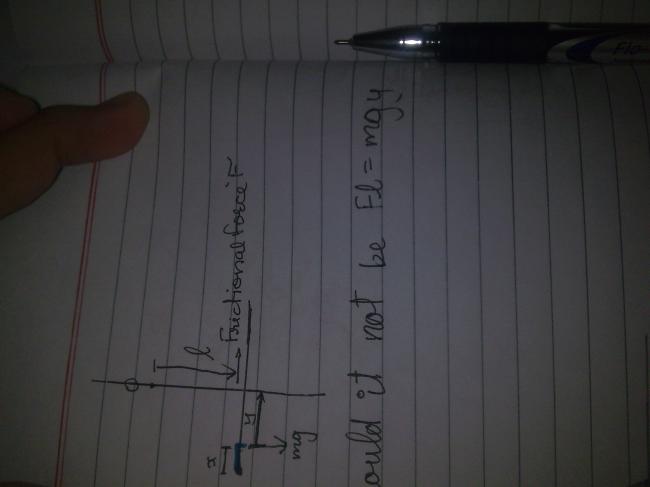 9
9r u guessing 173 jus bcos rt3 is given?
then u ve fallen into the trap set by the paper setter to confuse u
for a part of curve of path lenght dx inclined at θ
dW=Fdx=μmgcosθdx = μmgdl (hor comp of dx )
so final ans is always μmgl
forgive if nethins rong
 1
1n i dint guess 173 but calculated it....for for the last part of the journey the ball will atomatically cum down due to mgh and no work offriction is done....before it well have to take both gravity n friction...
 1
1and for q 21 ans is c bcoz....
the flux thru both the charges are equal so
Q1 2Π(1-cosα)=Q2 2Π(1-cosβ)
hence c
 1
1and our part B ans are the same...infact ever one in india wud have got those correct...
 1
1celes what i meant to say was dat...my 2, 8, 16 and 21 questions are wrong....the correct ans are the ones i have given at the end......
 9
9sid thanks a lot for ur cross chk
chk my part b ans also pls
1c
2a
3c
4b
5e
6e
7e
8a
9a
10b
11e
12b
13a
14b
15b
16c
17d
18c
19a
20c
 9
9heres the link for paper in pdf
http://olympiads.hbcse.tifr.res.in/uploads/inpho-2009
 9
9yes i to got gamma 3/2 and the graph
starts from 3 goes to ∞ at 1/2 and then comes down to 2 at 1
was urs similar ?
 9
9how are u telling
2 is c ( induced e field is independent of medium )
8 is c ( please explain ur approach , i derived it to be d )
16 (i ve marked d only ;) )
21 is c ( please explain how to do this )
 9
9hey sid frm were did u get sol ?
 1
1and the gamma in the subjective question i got 3/2
 1
1celes i am posting my ans here
as well as a few i know i have done wrong...
1c
2c
3d
4b
5c
6d
7b
8c
9
10a
11c
12d
13b
14a
15b
16d
17b
18a
19b
20a
21b
22c
23c
24c
25c
26a
27a
28d
29c
30a
31d
32c
33d
34a
35a
36a
37a
38b
The ans i know are wrong are..
2b
8d
16a
21c
 3
3Arre ya..dat is ok..but what to take as N in q 19..it varies, and work done by friction is path dependent, so why is it 20 J and not 173 J ??
 9
9u ve written x in place of y and y in place of x thats all
 1
1
i didnt get you why did you multiply x with gravitatnal force????
 9
9yes equate frictional torque to weight torque
so Fl = mgx
F= mgx/L
 1
1Hey Celestine!!
in the bug question 22,
can u tell wat hav u taken as "x"....is it horizontl disp of da bug?
i guess u hav done by equating the torques abt. centere of frame??
Can u plz expand a little
 9
9im tellin that after some time force will act
 9
9ans is b
use sine formula repeatedly
 13
13guyz the very 1st ques of this thread..ie the 13 th ques of the paper styl remains unanswered which troublin me for quite a few days nao...can sum 1 plzz help...
 9
9sid for q 19
ans is 0 !!!!! neither 20 nor 173 ?
 9
930 is c only chk the official sols at
http://olympiads.hbcse.tifr.res.in/uploads/inpho-2009-model-solutions
 3
3het in that 0 hinge force question is it a completely inelastic collision????????cint read sum parts of it!!!!!!!!
 3
3quite a simple paper for inpho!!!!!!!!!!!!!! i thought it wud be unsolvable!!!!!!
 3
330 is d ....im quite sure!!!!!!!
 9
9q 19 its μN X hor displacement
q 21 i ve already explained abv
 1
1thats what is given that no force will act....at the hinge...
 9
916 but afterwards force will act at hinge therby convertin linear to angular mom
